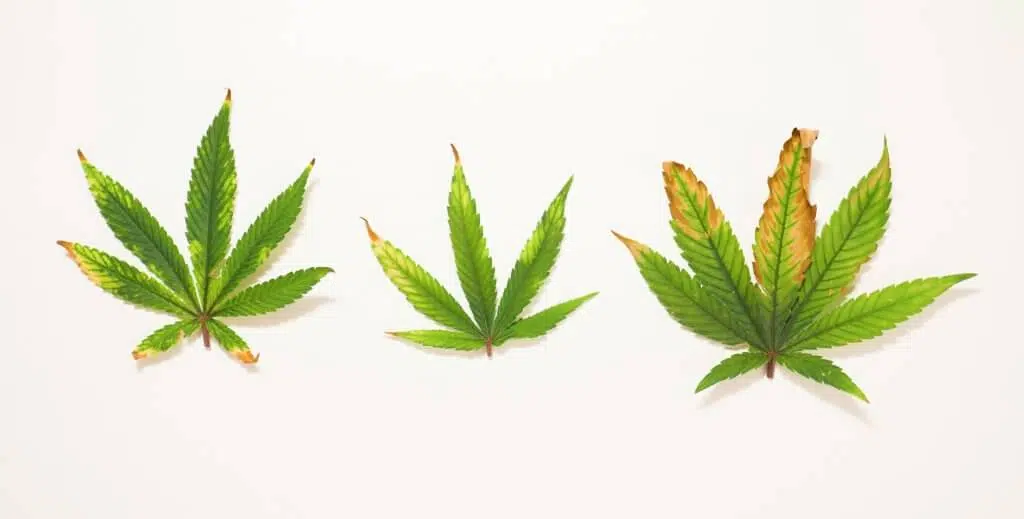Decoding Yellow Leaves: Flushing vs Nute Burn
- Magic Plants
- June 1, 2024
- No Comments
Decoding Yellow Leaves in Cannabis: Flushing vs. Nutrient Burn
Similar symptoms with key differences
 Figure 1. Flushing treatments were applied to The Hemp Mine Jack plants for 0, 1, 2 or 3 weeks prior to harvest. See full caption below.
Figure 1. Flushing treatments were applied to The Hemp Mine Jack plants for 0, 1, 2 or 3 weeks prior to harvest. See full caption below.
“Plants are ordered from 0 weeks to 3 weeks, left to right. The 0 week treatment (far left) was a control that was provided fertilizer for the duration of the experiment. Flower bud mass decreased with the 2- and 3-week flushing treatments, while the mass of the trim remained the same. Thus, flower:trim decreased, which is typically undesirable.” — Cannabis Research Coalition
Sponsored Content
Seeing Yellow Leaves? Learn Why
“It’s not always a bad thing, — in fact it’s something expert growers expect to see, often times during the best grows.” — Pro Grower
When growing cannabis, interpreting the color of the leaves can be crucial for understanding plant health and making the right cultivation decisions. This article dives deep into differentiating between yellowing leaves caused by late-stage flushing and those caused by nutrient burn, drawing on scientific research and expert cultivation practices.
 Figure 2. Flushing treatments were applied to THM Jack plants for 0 to 3 weeks prior to harvest. — Cannabis Research Coalition
Figure 2. Flushing treatments were applied to THM Jack plants for 0 to 3 weeks prior to harvest. — Cannabis Research Coalition
Understanding the Basics
Flushing: This is the deliberate process of ceasing to provide nutrients to cannabis plants, instead only using water to wash out excess salts and nutrients. This is typically done in the weeks leading up to harvest. The goal is to improve the quality of the buds by ensuring they do not retain an excess of nutrients that could affect the taste and burn quality.
Nutrient Burn: This occurs when plants receive too many nutrients, particularly nitrogen, phosphorus, or potassium, which can be toxic at high levels. It manifests as crispy, brown tips on leaves, progressing to more severe leaf scorching if unchecked.
 Figure 3. Burned, crispy brown tips and edges of the leaves indicate ‘nute burn’ or over-fertilization. This is distinct from the all-over yellow color that late stage flushing can bring. — PremiumCultivars
Figure 3. Burned, crispy brown tips and edges of the leaves indicate ‘nute burn’ or over-fertilization. This is distinct from the all-over yellow color that late stage flushing can bring. — PremiumCultivars
Signs of Yellowing Due to Flushing
During flushing, cannabis plants start using the residual nutrients stored in their foliage, which can lead to a uniform yellowing of leaves, especially the older, lower ones. This yellowing is a natural part of the plant redirecting energy to bud development and is typically seen as a whole-leaf discoloration without burnt tips or margins.
-
Uniform Color Change: The yellowing appears evenly across the leaf surface.
-
Progression: Starts from the older leaves and moves upwards as nutrient reserves are depleted.
Symptoms of Nutrient Burn
In contrast, nutrient burn involves more than just yellowing:
-
Tip Burn: The tips of the leaves turn brown and crispy, which is an early sign of nutrient burn.
-
Edge Progression: If excessive feeding continues, the burnt appearance can spread from the tips down the edges of the leaves.
-
Dark, Lush Green: Before the burn signs begin, leaves often exhibit a very dark green color due to excess nitrogen.
Leaf Color Chart

Figure 4. Various conditions of the cannabis leaf due to specific nutrient deficiencies and their associated color changes. — THCFarmer
Scientific Insight and Cultivation Tips
Recent studies, including those conducted by Rx Green Technologies, suggest that flushing reduces the concentration of certain nutrients in the buds but must be balanced against potential yield losses. Expert growers recommend careful monitoring of plant response during the flushing period to optimize the process without overstressing the plants.
For nutrient burn, the remedy involves reducing nutrient concentrations immediately and potentially flushing with plain water to help leach out excesses. Regular monitoring of runoff water’s EC (Electrical Conductivity) and pH can help avoid this issue by ensuring nutrient levels are not reaching harmful concentrations.
Practical Application
For growers, distinguishing between these two conditions involves careful observation and understanding the lifecycle of the cannabis plant:
-
Timing: Nutrient burn can occur at any time if the nutrients are too concentrated, whereas yellowing from flushing occurs predictably towards the end of the flowering cycle.
-
Management: Adjusting nutrient schedules according to plant stage and observing the plant’s response is crucial. Flushing should be timed based on the strain’s flowering duration and the grower’s goals for cannabinoid and terpene profiles.
Conclusion
Recognizing the differences between yellowing due to flushing and nutrient burn is critical for producing high-quality cannabis. Both scenarios reflect important feedback from your plants about their current conditions and needs. With careful management and observation, growers can maximize the health of their plants and the quality of their harvest.
This detailed approach to understanding the nuances of cannabis cultivation underscores the importance of both scientific research and practical knowledge in optimizing cannabis production and here at Glacier, we’ve harvested hundreds of crops to gain such insights.
Do you have questions about your grow? Feel free to ask us anything on our Instagram @GlacierCanna
— Magic Plants (Team Glacier)


